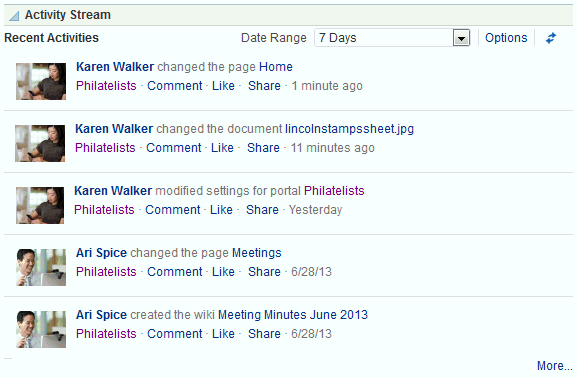41 Adding Activities to a Portal
This chapter describes how to add the Activity Stream and Recent Activities to a portal. Activities provide a streaming view of the actions performed by users' connections, actions taken in portals, and business activities. For example, Activity Stream can note when a user posts feedback, uploads a document, or creates a discussion forum. Additionally, it streams messages and attachments entered through the Publisher task flow. Recent Activities tracks the changes users make to application pages, documents, discussion forums, lists, and the like.
This chapter includes the following topics:
-
Section 41.1, "Comparison of Activity Stream and Recent Activities"
-
Section 41.3, "Adding an Activity Stream Task Flow to a Page"
-
Section 41.4, "Setting Activity Stream Task Flow Properties"
-
Section 41.7, "Adding a Recent Activities Task Flow to a Page"
-
Section 41.8, "Setting Recent Activities Task Flow Properties"
-
Section 41.9, "Working with the Recent Activities Task Flow"
Permissions:
To perform the tasks in this chapter, you must be a portal moderator or a portal member with the portal-level permissions Basic Services: Edit Page Access and Structure (standard permissions) or Pages: Edit Pages (advanced permissions).
For more information about permissions, see Section 29.1, "About Roles and Permissions for a Portal."
41.1 Comparison of Activity Stream and Recent Activities
Activity Stream and Recent Activities both track and report on activities in WebCenter Portal, enabling users to easily keep up with what is going on. However, there are two main differences between them. First, Activity Stream tracks a broader range of activities. For example, Recent Activities tracks the Documents (including wikis and blogs), Announcements, Discussions, and Page activities. Activity Stream tracks these activities as well as People Connections. Second, Recent Activities reports activities regardless of who performs the action. Activity Stream reports activities performed by a user's connections. There is a third, small difference—Activity Stream includes information about who performed the activity, whereas Recent Activities does not.
41.2 About the Activity Stream
In WebCenter Portal, Activity Stream provides a streaming view of the activities of users' connections, actions taken in portals, and business activities. For example, Activity Stream can note when a user posts feedback, uploads a document, or creates a discussion forum. Additionally, it streams messages and attachments entered through Publisher.
See Also:
For information about Publisher, see Section 41.10, "About Publisher."
Through Activity Stream Preferences, users can select to show connection and portal activities. (The system administrator can disable users from overriding application-level settings.)
In addition to streaming messages, the Activity Stream can provide access to file attachments and web links added through the Publisher task flow. Supported mime types can be fully previewed in the Activity Stream. Unsupported mime types are rendered as links, which you can use to access the file.
Activity Stream previews files through either a native web format or through Oracle WebCenter Content slide rendition. The previewer used depends on the mime type of the file to be previewed.
The mime types that use the native web format include the following:
-
image -
htm -
text
The mime types that use Oracle WebCenter Content slide rendition include the following:
-
pdf -
powerpoint -
powerpnt -
pptx
Note:
PDF file previews are available in Activity Stream when the mime type is pdf, webContextRoot is specified in the Oracle WebCenter Content connection, and the application is accessed through an Oracle HTTP Server.
The mime types shown in the previous lists are the only mime types that are previewed. Other mime types appear as links. The mime types docx and xlsx are not previewed in Activity Stream. A parameter associated with an Activity Stream task flow instance can be set to omit file previews (for more information, see Section 41.4.2, "Activity Stream Task Flow Parameters").
Users can share a streamed activity and its attachments using a Share feature, available on each streamed item.
See Also:
For information about using the Publisher task flow, see the "Liking, Commenting On, and Sharing Items in WebCenter Portal" chapter in Oracle Fusion Middleware Using Oracle WebCenter Portal.
Table 41-1 lists and describes the types of activities that are reported through Activity Stream.
Note:
Delete activities do not appear per se in the Activity Stream. But references to objects, such as Joe Smith created the document file.xml, are removed from the stream when such objects are deleted.
Table 41-1 Activities Tracked by Activity Stream
| Tool/Service | Tracked Activities | Scope | Activities Shared or Private |
|---|---|---|---|
|
Announcements |
|
|
Shared with other portal members |
|
Blogs |
|
|
|
|
Connections |
|
|
Shared with inviter and invitee's connections |
|
Discussions |
|
|
Shared with other portal members |
|
Documents |
|
|
|
|
Feedback |
|
|
Shared with whomever is permitted to view such activities |
|
Lists |
|
|
Shared with other portal members |
|
Message Board |
|
|
Shared with whomever is permitted to view such activities |
|
Pages |
|
|
|
|
Profiles |
|
|
Shared with whomever is permitted to view such activities |
|
Portal Events |
|
|
Shared with other portal members |
|
Portals Management |
|
|
Shared with other portal members |
|
Tagging |
|
|
|
Users can use Activity Stream Preferences to specify who can view their individual Activity Stream and the types of activities to show. For more information about Preferences relating to Activity Stream task flows, see the "Setting Activity Stream Preferences" section in Oracle Fusion Middleware Using Oracle WebCenter Portal.
In the page editor, use Activity Stream task flow properties to hide or show various controls on everyone's view of a task flow instance and to limit the types of objects and the specific portals that are tracked. For more information about Activity Stream task flow properties, see Section 41.4, "Setting Activity Stream Task Flow Properties."
WebCenter Portal provides the following Activity Stream task flows:
-
Activity Stream for viewing application activities and the activities of your connections and for providing access to the attachments added through the Share link (Figure 41-1)
This full view of Activity Stream functionality includes options for liking and commenting on listed activities and for sharing different types of objects, such as images, URLs, documents, and the like. Activity Stream also provides a means of hiding the activities and posts of a given user. You can use Activity Stream Options to show those users you have hidden.
The Activities page in the Home portal combines an instance of the Publisher task flow with the Activity Stream task flow.
-
Activity Stream - Quick View provides a summary view of application activities and the activities of your connections (Figure 41-2).
Figure 41-2 Activity Stream - Quick View Task Flow
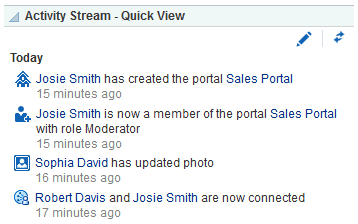
Description of "Figure 41-2 Activity Stream - Quick View Task Flow"
Unlike the full view of Activity Stream, Activity Stream - Quick View does not display Like, comments, and Share links. The Activity Stream - Quick View also combines similar activities into one entry. For example, if a user posts two documents, users see one entry that lists both documents; if a user posts two messages, user's see one entry that says the user "posted messages," but only the most recent message is shown.
A hierarchy of configuration settings control what users can do with their view of the Activity Stream. The system administrator sets application-wide values on the Administration page. Users can set their own personal values through People Connections Preferences. You can also set values on a given task flow instance in both the page editor, which affects all users' views of the task flow instance (application customization), and users can set values in page view mode, which affects only their view of the task flow (user customization).
Tip:
If users adjust a setting through Preferences that does not seem to affect the behavior of a task flow as expected, it may be because settings on the task flow itself override Preferences settings.
The Activity Stream task flow provides an Options link for accessing configuration settings for a given task flow instance (Figure 41-3).
Figure 41-3 Options Link for Activity Stream Options
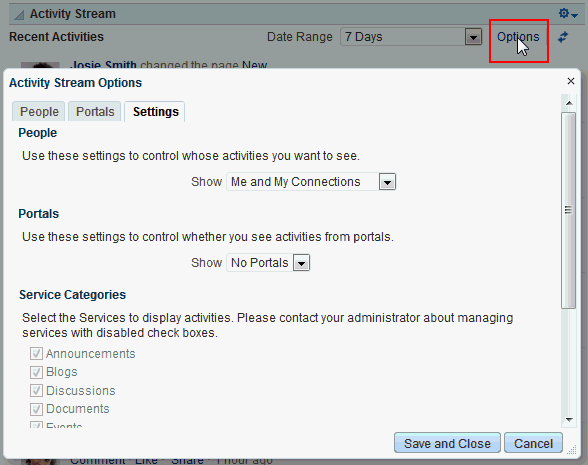
Description of "Figure 41-3 Options Link for Activity Stream Options"
The Activity Stream - Quick View provides access to its own configuration settings through a pencil icon (Change the source, filter, and display options) (Figure 41-4).
Figure 41-4 Pencil Icon and Resulting Configure Dialog
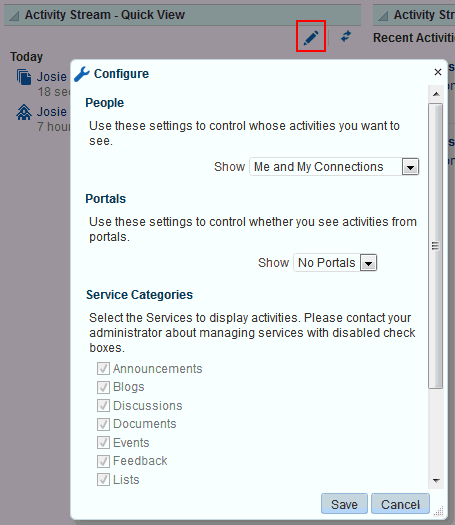
Description of "Figure 41-4 Pencil Icon and Resulting Configure Dialog"
Users use these controls to adjust an individual task flow instance with the same kinds of settings that are provided for all of their views of Activity Stream task flows through Activity Stream Preferences.
Clicking an object in an Activity Stream opens the object. For example, clicking the name of a newly created document in an Activity Stream opens the document. Clicking a user name in an Activity Stream opens a user profile pop-up. Clicking an attachment, such as a file or a URL, navigates you to that attachment.
See Also:
You can attach object to messages streamed from the Publisher task flow to the Activity Stream. For more information, see the "Liking, Commenting On, and Sharing Items in WebCenter Portal" chapter in Oracle Fusion Middleware Using Oracle WebCenter Portal.
System administrators can archive streamed activities to relieve the burden on your storage and to maintain a record of past activities. For more information, see the "Activity Stream" section in the Oracle Fusion Middleware WebLogic Scripting Tool Command Reference.
41.3 Adding an Activity Stream Task Flow to a Page
For the steps to add an Activity Stream task flow to a page, see Section 14.2, "Adding a Component to a Page."
41.4 Setting Activity Stream Task Flow Properties
Activity Stream task flows have associated properties, which users with sufficient privileges can access through the Component Properties dialog in Composer (Figure 41-5).
Tip:
For information about accessing the Component Properties dialog, see Section 14.3, "Modifying Components."
Figure 41-5 Activity Stream Task Flow Component Properties

Description of "Figure 41-5 Activity Stream Task Flow Component Properties"
The following sections provide information about properties associated with Activity Stream task flows and describe the properties available on the Parameters tab:
-
Section 41.4.1, "About Activity Stream Task Flow Properties"
-
Section 41.4.3, "Using an Advanced Query to Filter Activity Stream Items"
-
Section 41.4.4, "Using Properties to Configure an Activity Stream Task Flow Instance"
41.4.1 About Activity Stream Task Flow Properties
When you set property values on an Activity Stream task flow, you are affecting only the task flow instance on which the value is set. Other instances of the same task flow are not affected by such changes.
The properties on the Parameters tab of the Component Properties dialog can affect the default task flow content. For descriptions of the parameters on this tab, see Section 41.4.2, "Activity Stream Task Flow Parameters." For some task flows, parameters on this tab facilitate the wiring of the task flow to page parameters and page definition variables. For more information, see Chapter 19, "Wiring Pages, Task Flows, Portlets, and ADF Components."
Changes to the properties on the Display Options, Style, and Content Style tabs affect the appearance and behavior of the task flow. These properties are common to all task flows. For more information, see Section 14.3.4, "Working with Component Display Options" and Section 14.3.6, "Working with Style and Content Style Properties."
The content of the Events tab depends on the events supported by the task flow. For more information, see Section 14.3.7, "Working with Component Contextual Events."
All properties on the Parameters and Display Options tabs provide access to an Expression Language (EL) editor, which you can use to select or specify a variable value instead of a constant value. Click the ![]() icon next to a property, then select Expression Builder to open the editor. If you need EL assistance, an application developer can provide an EL expression; see the "Expression Language Expressions" appendix in Oracle Fusion Middleware Developing Portals with Oracle WebCenter Portal and Oracle JDeveloper
icon next to a property, then select Expression Builder to open the editor. If you need EL assistance, an application developer can provide an EL expression; see the "Expression Language Expressions" appendix in Oracle Fusion Middleware Developing Portals with Oracle WebCenter Portal and Oracle JDeveloper
Note:
Wherever you enter EL on the generic Display Options tab in the Component Properties dialog, the entry is automatically validated. If the EL syntax is invalid, an error appears and the value is neither applied nor saved. Generic Display Options are those cataloged in Table 14-1, "Display Options Properties".
EL validation is not performed on non-generic display options.
41.4.2 Activity Stream Task Flow Parameters
Table 41-2 describes the parameters that are unique to Activity Stream task flows.
Table 41-2 Activity Stream Task Flow Parameters
| Parameter | Description |
|---|---|
|
|
A field for specifying a custom query to filter streamed items For more information, see Section 41.4.3, "Using an Advanced Query to Filter Activity Stream Items." This parameter is associated with the Activity Stream task flow. |
|
|
A check box for specifying whether contextual information is shown when users click a Context Info icon 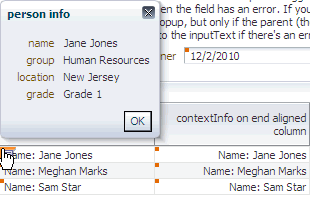 Description of the illustration wcsug_as_contextinfo.gif For example, if the item This parameter is primarily for use with WebCenter Portal Framework applications where, unless otherwise handled (such as the Profile popup on a user name), resources are rendered within the Resource Viewer system page.
This parameter is associated with the Activity Stream task flow. |
|
|
A check box for specifying whether a comments link is shown on a task flow instance
This parameter is associated with the Activity Stream task flow. |
|
|
A check box for specifying whether the Options link appears on the Activity Stream task flow or the pencil icon appears on Activity Stream - Quick View
This parameter is associated with the following task flows:
|
|
|
A check box for specifying whether to hide the controls that appear in the task flow header
This parameter is associated with the Activity Stream - Quick View task flow. |
|
|
A check box for specifying whether to hide previews of streamed files
For information about the mime types that are supported for file previewing in Activity Stream, see Section 41.2, "About the Activity Stream." This parameter is associated with the Activity Stream task flow. |
|
|
A check box for specifying whether to hide the Like link on streamed items
This parameter is associated with the Activity Stream task flow. |
|
|
A check box for specifying whether to hide the Share menu on streamed items
This parameter is associated with the Activity Stream task flow. |
|
|
Specifies whether to show the Portals options in the Activity Stream and Activity Stream - Quick View Configuration dialogs. The Portals options enable users to specify whether to show activities from all portals, the portals of which they are a member, no portals, or just the portal on which the task flow is placed.
This parameter is associated with the following task flows:
|
|
|
A field for entering the number of streamed items to show per page This parameter is associated with the following task flows:
|
|
|
A check box for specifying whether to provide Previous and Next links to enable users to page through streamed activities
This parameter is associated with the Activity Stream task flow. |
|
|
A check box for specifying whether to stream activities only from user profiles
This parameter is associated with the Activity Stream task flow. |
|
|
A field for entering the ID of the current user This value is provided by default, This parameter is associated with the Activity Stream - Quick View task flow. |
|
|
A field for entering the ID of the current user This value is provided by default, This parameter is associated with the Activity Stream task flow. |
|
|
A field for entering the IDs of components from which to stream activities Use this parameter to limit the display of streamed activities to only those associated with the specified component or components. Enter the category ID or the service ID. For a list of service IDs, see the "Service and Tool IDs" table in Oracle Fusion Middleware Developing Portals with Oracle WebCenter Portal and Oracle JDeveloper. This parameter is associated with the Activity Stream task flow. |
|
|
A field for entering the names of portals from which to stream activities Use this parameter to limit the display of streamed activities to only those associated with the specified portal or portals. Enter the GUID of the portal or the portal's internal name. The portal internal name is the name specified by the Portal URL on the General page of a portal's administration settings. Note that the activities that are streamed in an Activity Stream task flow that is scoped to a particular portal are visible to all members of that portal, regardless of whether they are formally connected to each other. This parameter is associated with the Activity Stream task flow. |
41.4.3 Using an Advanced Query to Filter Activity Stream Items
The Activity Stream task flow provides an Advanced Query parameter, which you can use to create custom filters against streamed activities using a SQL WHERE clause. For example, using SQL you can set up an Activity Stream instance to show only those activities relating to the page or streaming from the current user or a named user.
This section provides an overview of the Activity Stream Advanced Query option and steps you through the process of entering an advanced query. It includes the following subsections:
-
Section 41.4.3.1, "About the Activity Stream Advanced Query Option"
-
Section 41.4.3.2, "Entering an Advanced Query Against an Activity Stream Task Flow Instance"
41.4.3.1 About the Activity Stream Advanced Query Option
Use Advanced Query to create filters against user names, service IDs, and object details, such as a document's display name. You can use SQL syntax for parameter values. Additionally you can place EL expressions within the SQL.
You can construct queries against specific database objects, which are represented by aliases that are prefixed to the inquiry. Table 41-3 lists and describes the types of database objects against which you can construct a query and provides their alias prefixes.
See Also:
In many cases, you can use EL expressions to obtain the value you require for the supported fields and columns listed in Table 41-3.
If you need EL assistance, an application developer can provide an EL expression; see the "Expression Language Expressions" appendix in Oracle Fusion Middleware Developing Portals with Oracle WebCenter Portal and Oracle JDeveloper.
Table 41-3 Supported Database Objects for Constructing a SQL WHERE Clause
| Database Object | Alias Prefix | Supported Fields/Columns |
|---|---|---|
|
ACTIVITY |
AE |
|
|
ACTIVITY (ACTOR) |
AD |
|
|
ACTIVITY (OBJECT) |
OD |
|
Table 41-4 provides a list of valid activity type names for the ACTIVITY database object described in Table 41-3.
Table 41-4 Activity Type Names for Advanced Query
| Tool/Service | Activity Type Name |
|---|---|
|
Events |
|
|
Announcements |
|
|
Discussions |
|
|
Tags |
|
|
Lists |
|
|
Page |
|
|
Documents |
|
|
People Connections (Profile) |
|
|
People Connections (Message Board) |
|
|
People Connections (Connections) |
|
|
People Connections (Feedback) |
|
The SQL string that is passed as the advanced query parameter complies with SQL standards. That is, it supports SQL constructs, such as AND, OR, IN, and the like. Note, however, that it does not support INSERT, UPDATE, DELETE, SELECT, JOIN constructs. The syntax of the advanced query must contain only the WHERE clause portion of a SQL query. Because SELECT is not supported, the WHERE clause cannot have nested queries or subqueries.
The Advanced Query parameter also supports EL expressions, which can be embedded in the WHERE clause or used to generate the whole WHERE clause. If you need EL assistance, an application developer can provide an EL expression; see the "Expression Language Expressions" appendix in Oracle Fusion Middleware Developing Portals with Oracle WebCenter Portal and Oracle JDeveloper.
All the literals in the query must be escaped by prepending a backward slash (\), otherwise such characters generate syntax errors (see Table 41-5 for examples).
Note that the advanced query WHERE clause is always ANDed to the internal query that is generated by Activity Stream based on the current user, portal membership, connection list, and the like. This is to prevent a user from viewing activities to which he or she does not have access.
Table 41-5 lists examples of advanced queries.
Table 41-5 Examples of Advanced Queries for Use with Activity Stream
| Use Case | Query Syntax |
|---|---|
|
Stream only document creation activities. |
|
|
Stream activities only from an object or current portal. |
|
|
Stream activities only about wikis created by the current user. |
|
|
Stream activities for documents and discussions, but only create activities or all activities for the current user. |
|
41.4.3.2 Entering an Advanced Query Against an Activity Stream Task Flow Instance
To enter an advanced query against an instance of the Activity Stream task flow:
-
Open the Component Properties dialog for the Activity Stream task flow instance you want to configure.
See Also:
-
In the Component Properties dialog, on the Parameters tab, provide a value for the property
Advanced Query.See Also:
See Section 41.4.3.1, "About the Activity Stream Advanced Query Option," for information about the type and format of values to provide for this field.
-
When you finish revising component properties, click OK.
-
Save your changes, and exit the page editor.
Going forward, streamed activities are filtered by your query.
41.4.4 Using Properties to Configure an Activity Stream Task Flow Instance
This section provides examples of how you use property values to affect the behavior of a given task flow instance. It includes the following subsections:
-
Section 41.4.4.1, "Preventing Users from Customizing an Activity Stream"
-
Section 41.4.4.3, "Preventing Users from Commenting on Streamed Items"
-
Section 41.4.4.4, "Preventing Users from Liking Streamed Items"
-
Section 41.4.4.5, "Preventing Users from Sharing Streamed Items"
-
Section 41.4.4.6, "Hiding Home Portals Options in Activity Stream Task Flows"
-
Section 41.4.4.7, "Limiting the Stream to Activities from One or More Portals"
-
Section 41.4.4.8, "Limiting the Stream to One or More Services"
-
Section 41.4.4.9, "Limiting the Stream to Your Own Activities"
41.4.4.1 Preventing Users from Customizing an Activity Stream
By default, Activity Stream task flows provide user customization controls that enable users to specify whose actions they want to see and from what services and portals in a given Activity Stream task flow. On the Activity Stream task flow, this is the Options link. On the Activity Stream - Quick View task flow, this is the pencil icon.
The Hide Configuration Button property is available when you want to prevent users from overriding application-level customizations with their own user-level customizations.
To prevent users from customizing an Activity Stream task flow instance:
-
Open the Component Properties dialog for the Activity Stream task flow instance you want to configure.
See Also:
-
In the Component Properties dialog, on the Parameters tab, select Hide Configuration Button.
Note:
To show the Options link or pencil icon, deselect Hide Configuration Button.
-
When you finish revising component properties, click OK.
-
Save your changes, and exit the page editor.
41.4.4.2 Hiding File Previews in Streamed Items
By default, in most cases where an Activity Stream item has an associated file, such as a document or an image, both a file link and a file preview are shown with the item (Figure 41-6).
Figure 41-6 Previewed File in Activity Stream
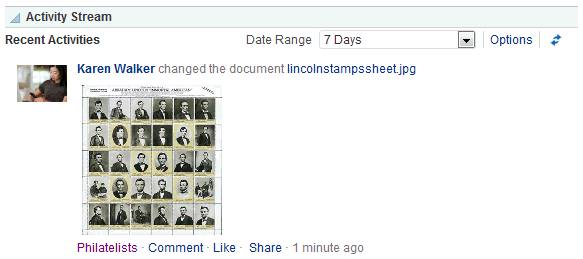
Description of "Figure 41-6 Previewed File in Activity Stream"
Activity Stream previews files through either a native web format or through Oracle WebCenter Content slide rendition. The previewer used depends on the mime type of the file to be previewed.
The mime types that use the native web format include the following:
-
image -
htm -
text -
pdf
The mime types that use Oracle WebCenter Content slide rendition include the following:
-
powerpoint -
powerpnt -
pptx
Note that the mime types shown in these bullet lists are the only mime types that are previewed. Other mime types appear as links.
You can use the Hide Inline Preview property to suppress the file preview, leaving the link for accessing the file should users want to do so.
The Hide Inline Preview property is provide with the Activity Stream task flow.
To hide a file preview in streamed items:
-
Open the Component Properties dialog for the Activity Stream task flow instance you want to configure.
See Also:
-
In the Component Properties dialog, on the Parameters tab, select Hide Inline Preview.
Note:
To show file previews, deselect Hide Inline Preview.
-
When you finish revising component properties, click OK.
-
Save your changes, and exit the page editor.
41.4.4.3 Preventing Users from Commenting on Streamed Items
By default, a comments link is shown with all items in an Activity Stream task flow to enable users to comment on a given item (Figure 41-7).
Figure 41-7 Comments Link on a Streamed Item

Description of "Figure 41-7 Comments Link on a Streamed Item"
You can use the Hide Comments property to suppress the display of the Comment link and, consequently, prevent users from commenting on streamed items in a given task flow instance.
To prevent users from commenting on streamed items:
-
Open the Component Properties dialog for the Activity Stream task flow instance you want to configure.
See Also:
-
In the Component Properties dialog, on the Parameters tab, select Hide Comments.
Note:
To show the Comment link on streamed items, deselect Hide Comments.
-
When you finish revising component properties, click OK.
-
Save your changes, and exit the page editor.
41.4.4.4 Preventing Users from Liking Streamed Items
By default, a Like link is shown with all items in an Activity Stream task flow to enable users to express a favorable opinion of a given item (Figure 41-8).
Once clicked, the Like link switches to an Unlike link to enable users to undo their favorable opinion.
You can use the Hide Like property to suppress the display of the Like link, and, consequently, prevent users from liking streamed items in a given task flow instance.
To prevent users from liking streamed items:
-
Open the Component Properties dialog for the Activity Stream task flow instance you want to configure.
See Also:
-
In the Component Properties dialog, on the Parameters tab, select Hide Like.
Note:
To show the Like link on streamed items, deselect Hide Like.
-
When you finish revising component properties, click OK.
-
Save your changes, and exit the page editor.
41.4.4.5 Preventing Users from Sharing Streamed Items
By default, a Share menu is shown with all items in an Activity Stream task flow to enable users to share a streamed item with their connections (Figure 41-9).
Figure 41-9 Share Menu on a Streamed Item

Description of "Figure 41-9 Share Menu on a Streamed Item"
You can use the Hide Share property to suppress the display of the Share menu, and, consequently prevent users from sharing streamed items from a given task flow instance.
To prevent users from sharing streamed items:
-
Open the Component Properties dialog for the Activity Stream task flow instance you want to configure.
See Also:
-
In the Component Properties dialog, on the Parameters tab, select Hide Share.
Note:
To show the Share option on streamed items, deselect Hide Share.
-
When you finish revising component properties, click OK.
-
Save your changes, and exit the page editor.
41.4.4.6 Hiding Home Portals Options in Activity Stream Task Flows
By default, users see Portals options on the Settings tab of the Activity Stream and Activity Stream - Quick View Options dialogs (Figure 41-10). The Portals options enable users to specify whether to show activities from all portals, the portals of which they are a member, no portals, or just the portal on which the task flow is placed.
Figure 41-10 Portals Options on Settings Page of Activity Stream Options Dialog
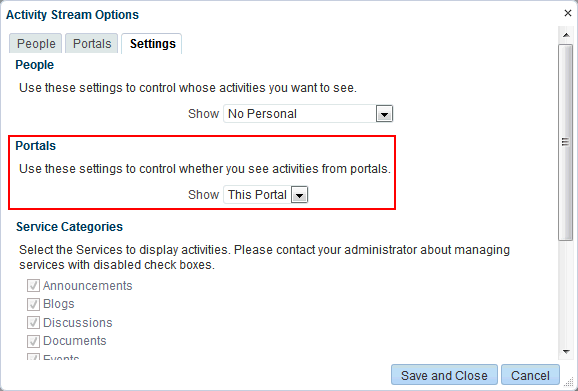
Description of "Figure 41-10 Portals Options on Settings Page of Activity Stream Options Dialog"
-
Select the check box to show the Portals options. This is the default (
#{true}). -
Deselect the check box to hide the Portals options (
#{false}).
This parameter is associated with the following task flows:
-
Activity Stream
-
Activity Stream - Quick View
You can use the Hide Portal Options property to suppress the display of the Portals section on the Settings page of the Activity Stream task flow Options dialogs.
To hide the Portals options:
-
Open the Component Properties dialog for the Activity Stream task flow instance you want to configure.
See Also:
-
In the Component Properties dialog, on the Parameters tab, select Hide Portals Options.
Note:
To show the Portals options, deselect Hide Portals Options.
-
When you finish revising component properties, click OK.
-
Save your changes, and exit the page editor.
41.4.4.7 Limiting the Stream to Activities from One or More Portals
Configuration options in both the Activity Stream and Activity Stream - Quick View task flows provide all-or-none options for streaming activities from portals (see the "Tracking Portal Activities" chapter in Oracle Fusion Middleware Using Oracle WebCenter Portal).
The Portals property associated with the Activity Stream task flow provides the additional dimension of selecting specific portals from which to stream activities.
To limit the stream to activities from one or more portals:
-
Open the Component Properties dialog for the Activity Stream task flow instance you want to configure.
See Also:
-
In the Component Properties dialog, on the Parameters tab, in the
Portalsfield, enter a comma-separated list of the portal names or portal GUIDs from which to stream activities in this task flow instance.Tip:
Enter the portal internal name. The portal internal ID is specified on the Overview page of a portal's administration settings.
-
When you finish revising component properties, click OK.
-
Save your changes, and exit the page editor.
41.4.4.8 Limiting the Stream to One or More Services
Configuration options for both the Activity Stream and Activity Stream - Quick View task flows provide a means of selecting the service categories from which to stream activities (see the "Tracking Portal Activities" chapter in Oracle Fusion Middleware Using Oracle WebCenter Portal).
The Service Categories property associated with the Activity Stream task flow extends this capability by enabling you to enforce a particular selection. For example, you can specify the service category documents, and only those connections' activities that stream from the Documents tool are shown in the task flow instance.
To limit streamed activities to one or more services:
-
Open the Component Properties dialog for the Activity Stream task flow instance you want to configure.
See Also:
-
In the Component Properties dialog, on the Parameters tab, in the
Service Categoriesfield, enter a comma-separated list of the services from which to stream activities in this task flow instance.Tip:
Enter the service category ID or the service ID. For a list of valid service IDs, see the "Service and Tool IDs" table in Oracle Fusion Middleware Developing Portals with Oracle WebCenter Portal and Oracle JDeveloper.
-
When you finish revising component properties, click OK.
-
Save your changes, and exit the page editor.
41.4.4.9 Limiting the Stream to Your Own Activities
You can use the Profile Only property associated with the Activity Stream task flow to limit the display of streamed activities to just the user's own activities.
To limit streamed activities to just the user's own activities:
-
Open the Component Properties dialog for the Activity Stream task flow instance you want to configure.
See Also:
-
In the Component Properties dialog, on the Parameters tab, select Profile Only.
Note:
To show a user's own activities and those of their connections, deselect Profile Only.
-
When you finish revising component properties, click OK.
-
Save your changes, and exit the page editor.
41.5 Working with Activity Stream Task Flows
For information about how users work with Profile task flows, see the "Tracking Portal Activities" chapter in Oracle Fusion Middleware Using Oracle WebCenter Portal.
41.6 About Recent Activities
The Recent Activities task flow links to the additions and revisions to some tools and services available to your application.
Tracked changes include additions and revisions to pages, documents, discussion forums, lists, and events (Figure 41-11).
Figure 41-11 The Recent Activities Task Flow

Description of "Figure 41-11 The Recent Activities Task Flow"
By default, the Recent Activity list displays 25 recent activities for a given tool or service. If more than 25 activities have occurred, then the Recent Activity list displays the 25 most recent. System administrators can change the default value, so the limit may be more or less than 25.
The level of information provided in the Recent Activity list depends on the context in which the list is placed. For example, in a Portal Portal Framework application, changes are tracked on all applicable services across the entire application.
In a portal page, the Recent Activity list summarizes changes occurring in that portal. In a personal portal, the Recent Activities task flow must have a portal specified (see Section 41.8, "Setting Recent Activities Task Flow Properties"). The Recent Activity list summarizes changes occurring in the specified portal.
You can use the Recent Activity list as an access point to new and revised content. The Recent Activity list displays new and revised content as links, which you can click to go directly to the content.
41.7 Adding a Recent Activities Task Flow to a Page
For the steps to add a Recent Activities task flow to a page, see Section 14.2, "Adding a Component to a Page."
41.8 Setting Recent Activities Task Flow Properties
The Recent Activities task flows have associated properties, which users with sufficient privileges can access through the Component Properties dialog in Oracle WebCenter Portal's Composer (Figure 41-12).
Tip:
For information about accessing the Component Properties dialog, see Section 14.3, "Modifying Components."
Figure 41-12 Recent Activities Task Flow Component Properties
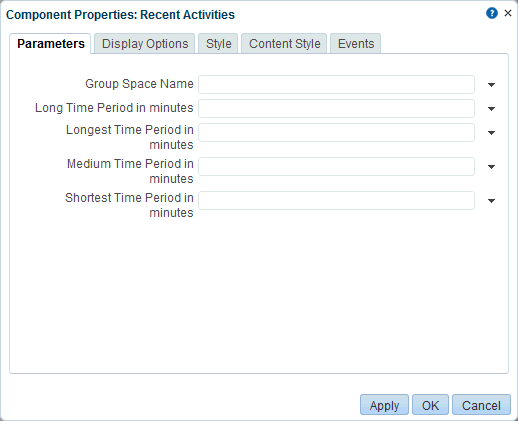
Description of "Figure 41-12 Recent Activities Task Flow Component Properties"
The following sections provide information about properties of the Recent Activities task flow and describe the properties on the Parameters tab:
41.8.1 About the Recent Activities Task Flow Properties
When you set property values on a Recent Activities task flow, you are affecting only the task flow instance on which the value is set. Other instances of the same task flow are not affected by such changes.
The properties on the Parameters tab of the Component Properties dialog can affect the default task flow content. For descriptions of the parameters on this tab, see Section 41.8.2, "Recent Activities Task Flow Parameters." For some task flows, parameters on this tab facilitate the wiring of the task flow to page parameters and page definition variables. For more information, see Chapter 19, "Wiring Pages, Task Flows, Portlets, and ADF Components."
Changes to the properties on the Display Options, Style, and Content Style tabs affect the appearance and behavior of the task flow. These properties are common to all task flows. For more information, see Section 14.3.4, "Working with Component Display Options" and Section 14.3.6, "Working with Style and Content Style Properties."
The content of the Events tab depends on the events supported by the task flow. For more information, see Section 14.3.7, "Working with Component Contextual Events."
All properties on the Parameters and Display Options tabs provide access to an Expression Language (EL) editor, which you can use to select or specify a variable value instead of a constant value. Click the ![]() icon next to a property, then select Expression Builder to open the editor. If you need EL assistance, an application developer can provide an EL expression; see the "Expression Language Expressions" appendix in Oracle Fusion Middleware Developing Portals with Oracle WebCenter Portal and Oracle JDeveloper
icon next to a property, then select Expression Builder to open the editor. If you need EL assistance, an application developer can provide an EL expression; see the "Expression Language Expressions" appendix in Oracle Fusion Middleware Developing Portals with Oracle WebCenter Portal and Oracle JDeveloper
Note:
Wherever you enter EL on the generic Display Options tab in the Component Properties dialog, the entry is automatically validated. If the EL syntax is invalid, an error appears and the value is neither applied nor saved. Generic Display Options are those cataloged in Table 14-1, "Display Options Properties".
EL validation is not performed on non-generic display options.
41.8.2 Recent Activities Task Flow Parameters
Table 41-6 describes the parameters that are unique to the Recent Activities task flow.
Table 41-6 Recent Activities Task Flow Parameters
| Parameter | Description |
|---|---|
|
|
Applicable in WebCenter Portal only. Leave this field blank if the task flow is on a Portal Framework application page. Use this parameter to specify the portal for which to display recent activities. On a personal portal page, use this to narrow the range of displayed activities. Rather than tracking activities application-wide—the default behavior—you can, for example, set a Constant value of a particular portal's display name. On a portal page, use this parameter to display some other portal's recent activities or to display recent activities for all portals. Valid values include:
|
|
|
Defaults to Valid values include:
Example values:
Constant: TODAY (Displays all activity since midnight)
Constant: 2880 (Displays all activity within the last 2880 minutes. This is displayed as Last 2 Days on the Show menu.)
EL Expression: ${myAppBean.timePeriod} (Displays based on the value from the given Bean property "timePeriod")
|
|
|
Defaults to Valid values include:
Example values:
Constant: TODAY (Displays all activity since midnight)
Constant: 2880 (Displays all activity within the last 2880 minutes. This is displayed as Last 2 Days on the Show menu.)
EL Expression: ${myAppBean.timePeriod} (Displays based on the value from the given Bean property "timePeriod")
|
|
|
Defaults to Valid values include:
Example values:
Constant: TODAY (Displays all activity since midnight)
Constant: 2880 (Displays all activity within the last 2880 minutes. This is displayed as Last 2 Days on the Show menu.)
EL Expression: ${myAppBean.timePeriod} (Displays based on the value from the given Bean property "timePeriod")
|
|
|
Defaults to Valid values include:
Example values:
Constant: TODAY (Displays all activity since midnight)
Constant: 2880 (Displays all activity within the last 2880 minutes. This is displayed as Last 2 Days on the Show menu.)
EL Expression: ${myAppBean.timePeriod} (Displays based on the value from the given Bean property "timePeriod")
|
41.9 Working with the Recent Activities Task Flow
For information about how users work with Profile task flows, see the "Tracking Portal Activities" chapter in Oracle Fusion Middleware Using Oracle WebCenter Portal.
41.10 About Publisher
The Publisher task flow provides a means of publishing messages, files, and URLs to the Activity Streams of all of your connections or to those connections who have access to a specified portal. Publisher also has an associated property, Is Update Status, that enables users to publish a message as their Profile status message.
See Also:
For information about Activity Stream, see Section 41.2, "About the Activity Stream." For information about Profiles, see Chapter 53, "Adding Profiles to a Portal." For information about properties associated with the Publisher task flow, see Section 41.12, "Setting the Publisher Task Flow Properties."
The Publisher task flow is very similar in operation to Message Board task flows (see Chapter 49, "Adding Messages and Feedback to a Portal"). It differs in a few ways:
-
You can use it to send out messages, but not to receive them. It provides no feature for viewing messages.
-
It is specifically made to work in conjunction with Activity Stream, where the messages you enter are published.
-
It has its own distinct set of properties (see Section 41.12, "Setting the Publisher Task Flow Properties").
-
It is not controlled by configuration settings at the application level nor through a user's personal Preferences. Users specify who sees their published messages through a control on the task flow itself. You can also exercise some control over the message destination through task flow properties. For example, the Publisher task flow has an associated property,
Is Update Status, that shows the last published message as the user's Profile status message.See Also:
For information about Profile, see Chapter 53, "Adding Profiles to a Portal."
There is one Publisher task flow, but depending on how you set the properties, it can show options for sharing messages, files, or links (Figure 41-13) or just show options for sharing documents (Figure 41-14).
Figure 41-14 Publisher Task Flow with Upload Document Only Option
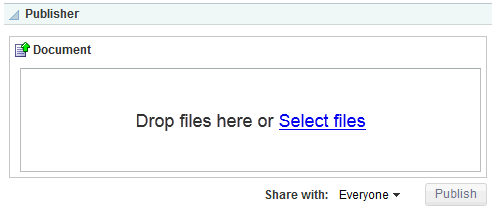
Description of "Figure 41-14 Publisher Task Flow with Upload Document Only Option"
In default WebCenter Portal installations, the Publisher task flow is placed on the Activities business role page, which is provided in the Home portal for all authenticated users (that is, users who are logged in).
The default Activities business role page also contains an Activity Stream task flow where the messages you enter through the Publisher are published.
See Also:
For more information about business role pages, see the "Managing Business Role Pages" chapter in Oracle Fusion Middleware Administering Oracle WebCenter Portal.
41.11 Adding a Publisher Task Flow to a Page
For the steps to add a Publisher task flow to a page, see Section 14.2, "Adding a Component to a Page."
41.12 Setting the Publisher Task Flow Properties
The Publisher task flow has associated properties, which users with sufficient privileges can access through the Component Properties dialog in Composer (Figure 41-15).
Tip:
For information about accessing the Component Properties dialog, see Section 14.3, "Modifying Components."
Figure 41-15 Publisher Parameters in the Component Properties Dialog

Description of "Figure 41-15 Publisher Parameters in the Component Properties Dialog"
The following sections provide information about properties associated with the Publisher task flow and describe the properties available on the Parameters tab:
-
Section 41.12.3, "Prohibiting File Uploads Through a Publisher Task Flow Instance"
-
Section 41.12.5, "Using the Publisher as a Profile Status Updater"
41.12.1 About Publisher Task Flow Properties
When you set property values on the Publisher task flow, you are affecting only the task flow instance on which the value is set. Other instances of the same task flow are not affected by such changes.
The properties on the Parameters tab of the Component Properties dialog can affect the default task flow content. For descriptions of the parameters on this tab, see Section 41.12.2, "Publisher Task Flow Parameters." For some task flows, parameters on this tab facilitate the wiring of the task flow to page parameters and page definition variables. For more information, see Chapter 19, "Wiring Pages, Task Flows, Portlets, and ADF Components."
Changes to the properties on the Display Options, Style, and Content Style tabs affect the appearance and behavior of the task flow. These properties are common to all task flows. For more information, see Section 14.3.4, "Working with Component Display Options" and Section 14.3.6, "Working with Style and Content Style Properties."
The content of the Events tab depends on the events supported by the task flow. For more information, see Section 14.3.7, "Working with Component Contextual Events."
All properties on the Parameters and Display Options tabs provide access to an Expression Language (EL) editor, which you can use to select or specify a variable value instead of a constant value. Click the ![]() icon next to a property, then select Expression Builder to open the editor. If you need EL assistance, an application developer can provide an EL expression; see the "Expression Language Expressions" appendix in Oracle Fusion Middleware Developing Portals with Oracle WebCenter Portal and Oracle JDeveloper
icon next to a property, then select Expression Builder to open the editor. If you need EL assistance, an application developer can provide an EL expression; see the "Expression Language Expressions" appendix in Oracle Fusion Middleware Developing Portals with Oracle WebCenter Portal and Oracle JDeveloper
Note:
Wherever you enter EL on the generic Display Options tab in the Component Properties dialog, the entry is automatically validated. If the EL syntax is invalid, an error appears and the value is neither applied nor saved. Generic Display Options are those cataloged in Table 14-1, "Display Options Properties".
EL validation is not performed on non-generic display options.
41.12.2 Publisher Task Flow Parameters
Table 41-7 describes the parameters that are unique to the Publisher task flow.
Table 41-7 Publisher Task Flow Parameters
| Parameter | Description |
|---|---|
|
|
Specifies whether the Attach: File | Link option is shown or hidden
The Attach: File | Link option is shown by default. |
|
|
Specifies whether the File link is available on the task flow for uploading a document
The File link is shown by default. Note: Do not select this option if the |
|
|
Specifies whether the Share with menu is shown or hidden
The Share with menu is shown by default. |
|
|
Indicates whether the message entered in the task flow instance should also be published as the user's Profile status message
If you attach a file or URL to a published message, then the message is not used as a Profile status message, even if For information about Profiles, see Chapter 53, "Adding Profiles to a Portal." |
|
|
Specifies whether Publisher remains open after a user clicks the Publish button
Publisher remains open after a message is published by default. |
|
|
Specifies the resource bundle class and message key for hint text Use the format |
|
|
The ID of the object to be shared This property value assists in generating a link for use in navigating to the published object. It is not necessary to provide a value, unless you plan to do so using an EL expression. If you need EL assistance, an application developer can provide an EL expression; see the "Expression Language Expressions" appendix in Oracle Fusion Middleware Developing Portals with Oracle WebCenter Portal and Oracle JDeveloper |
|
|
The type of object to be shared This property value assists in generating a link for use in navigating to the published object. It is not necessary to provide a value, unless you plan to do so using an EL expression. If you need EL assistance, an application developer can provide an EL expression; see the "Expression Language Expressions" appendix in Oracle Fusion Middleware Developing Portals with Oracle WebCenter Portal and Oracle JDeveloper |
|
|
The ID of the scope to which to publish This property value assists in generating a link for use in navigating to the published object. It is not necessary to provide a value, unless you plan to do so using an EL expression. If you need EL assistance, an application developer can provide an EL expression; see the "Expression Language Expressions" appendix in Oracle Fusion Middleware Developing Portals with Oracle WebCenter Portal and Oracle JDeveloper |
|
|
The service ID of the service to which the shared object belongs This property value assists in generating a link for use in navigating to the published object. It is not necessary to provide a value, unless you plan to do so by entering a specific service ID or using an EL expression. For a list of valid service IDs, see the "Service and Tool IDs" table in Oracle Fusion Middleware Developing Portals with Oracle WebCenter Portal and Oracle JDeveloper. If you need EL assistance, an application developer can provide an EL expression; see the "Expression Language Expressions" appendix in Oracle Fusion Middleware Developing Portals with Oracle WebCenter Portal and Oracle JDeveloper |
|
|
The name of the portal in which to publish the messages entered in this task flow instance Enter the portal internal name and not the portal display name. The portal internal name is the name specified by the portal URL on the General page of a portal's administration settings. The portal display name is specified by Display Name, and is the name that appears in the portal banner at the top of the portal. |
|
|
Specifies that Publisher shows only the document upload feature, hiding the text entry area and the Attach: Link option (Figure 41-14)
This option is not enabled by default. Note: If you select this option, make sure the |
|
|
The name of the user who owns the current view This value is supplied by default. We recommend that you not change the default value, |
|
|
The user name of the person who provided the object the current user is sharing For example, if John is shares a document with everyone that Jane originally shared with him, Jane is the "via" user. |
41.12.3 Prohibiting File Uploads Through a Publisher Task Flow Instance
You can use the Hide Document Uploader property to omit the display of the Attach: File option on a Publisher task flow instance. Users will be able to share links but not files.
To prohibit file uploads through a Publisher task flow instance:
-
Open the Component Properties dialog for the Publisher task flow instance you want to configure.
See Also:
-
In the Component Properties dialog, on the Parameters tab, select Hide Document Uploader.
Note:
To show the Attach: File option, deselect Hide Document Uploader.
-
When you finish revising component properties, click OK.
-
Save your changes, and exit the page editor.
41.12.4 Limiting the Scope of Recipients
You can use the Space Name property to limit the scope of recipients of published messages to a user's connections in a particular portal. When you do this, the message does not even stream to your own view of the Activity Stream in the Home portal. It is streamed only to your and your connections' views of the Activity Stream in the named portal.
To limit the scope of recipients to a particular portal:
-
Open the Component Properties dialog for the Publisher task flow instance you want to configure.
See Also:
-
In the Component Properties dialog, on the Parameters tab, enter the internal name of the portal in the
Portal Namefield.Tip:
The portal internal name is the name specified by the portal URL on the General page of a portal's administration settings. The portal display name is specified by Display Name, and is the name that appears in the portal banner at the top of the portal.
-
When you finish revising component properties, click OK.
-
Save your changes, and exit the page editor.
Messages posted through that Publisher task flow instance will be shared with only those connections who have access to the named portal.
41.12.5 Using the Publisher as a Profile Status Updater
You can use the Is Update Status property to specify that all messages without attachments are published not only to specified recipients, but also as the user's Profile status message (Figure 41-16).
Figure 41-16 Published Message Used as Profile Status

Description of "Figure 41-16 Published Message Used as Profile Status"
Messages that have an attached file or link are not simultaneously published as a Profile status message.
To specify that messages are also published as Profile status messages:
-
Open the Component Properties dialog for the Publisher task flow instance you want to configure.
See Also:
-
In the Component Properties dialog, on the Parameters tab, select Is Update Status.
Note:
To prevent messages posted through Publisher from being published as a user's Profile status message, deselect Is Update Status.
-
When you finish revising component properties, click OK.
-
Save your changes, and exit the page editor.
Messages that do not include attachments that are posted through that Publisher task flow instance are also shared as the user's personal Profile status message.
41.12.6 Using the Publisher as a File Uploader
You can use the Upload Document Only property to limit the functionality of the Publisher task flow to a file uploader (Figure 41-17).
Figure 41-17 Publisher Task Flow as Document Uploader

Description of "Figure 41-17 Publisher Task Flow as Document Uploader"
Files uploaded through the Publisher task flow are placed in the Public folder in the document library of the selected scope. That is:
-
In the Home portal:
-
Select Everyone to publish the file to the Public folder in each of your connections' personal Document Library.
-
Select a named portal to publish the file to the Public folder in the selected portal's Document Library.
-
-
In a portal, the file is published to the Public folder in the portal's Document Library.
To use the Publisher task flow as a file uploader:
-
Open the Component Properties dialog for the Activity Stream task flow instance you want to configure.
See Also:
-
In the Component Properties dialog, on the Parameters tab, select Upload Document Only.
Note:
To show the message and link controls, deselect Upload Document Only.
-
When you finish revising component properties, click OK.
-
Save your changes, and exit the page editor.
The Publisher task flow instance renders as a file uploader (see Figure 41-17). The text area and the Share link icon are not rendered.
41.13 Working with the Publisher Task Flow
For information about how users work with Profile task flows, see the "Liking, Commenting On, and Sharing Items in WebCenter Portal" chapter in Oracle Fusion Middleware Using Oracle WebCenter Portal.
